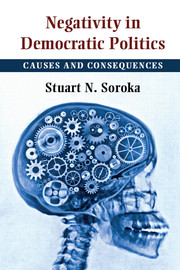Book contents
- Frontmatter
- Contents
- Figures
- Tables
- Preface
- Acknowledgments
- 1 On Negativity
- 2 Negativity in Politics
- 3 (Political) Impression Formation
- 4 Economic Sentiment and Government Approval
- 5 Media Content
- 6 Reactions to News Content
- 7 Negativity in Political Institutions
- Appendix A
- Appendix B
- Bibliography
- Index
- References
Bibliography
Published online by Cambridge University Press: 05 June 2014
- Frontmatter
- Contents
- Figures
- Tables
- Preface
- Acknowledgments
- 1 On Negativity
- 2 Negativity in Politics
- 3 (Political) Impression Formation
- 4 Economic Sentiment and Government Approval
- 5 Media Content
- 6 Reactions to News Content
- 7 Negativity in Political Institutions
- Appendix A
- Appendix B
- Bibliography
- Index
- References
- Type
- Chapter
- Information
- Negativity in Democratic PoliticsCauses and Consequences, pp. 145 - 178Publisher: Cambridge University PressPrint publication year: 2014

